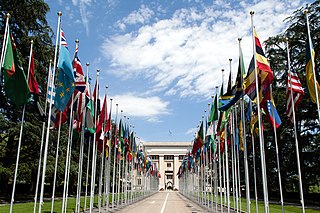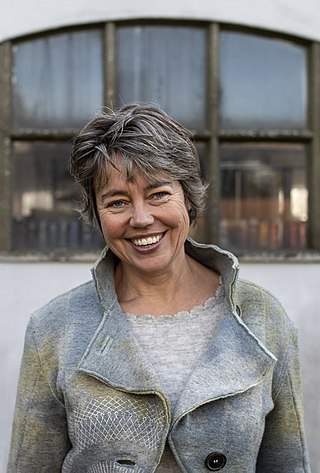
A flag is a piece of fabric with distinctive colours and design. It is used as a symbol, a signalling device, or for decoration. The term flag is also used to refer to the graphic design employed, and flags have evolved into a general tool for rudimentary signalling and identification, especially in environments where communication is challenging. Many flags fall into groups of similar designs called flag families. The study of flags is known as "vexillology" from the Latin vexillum, meaning "flag" or "banner".

A mirror, also known as a looking glass, is an object that reflects an image. Light that bounces off a mirror will show an image of whatever is in front of it, when focused through the lens of the eye or a camera. Mirrors reverse the direction of the image in an equal yet opposite angle from which the light shines upon it. This allows the viewer to see themselves or objects behind them, or even objects that are at an angle from them but out of their field of view, such as around a corner. Natural mirrors have existed since prehistoric times, such as the surface of water, but people have been manufacturing mirrors out of a variety of materials for thousands of years, like stone, metals, and glass. In modern mirrors, metals like silver or aluminium are often used due to their high reflectivity, applied as a thin coating on glass because of its naturally smooth and very hard surface.

Screen printing is a printing technique where a mesh is used to transfer ink onto a substrate, except in areas made impermeable to the ink by a blocking stencil. A blade or squeegee is moved across the screen in a "flood stroke" to fill the open mesh apertures with ink, and a reverse stroke then causes the screen to touch the substrate momentarily along a line of contact. This causes the ink to wet the substrate and be pulled out of the mesh apertures as the screen springs back after the blade has passed. One colour is printed at a time, so several screens can be used to produce a multi-coloured image or design.

Mark Wallinger is an English artist. Having previously been nominated for the Turner Prize in 1995, he won in 2007 for his installation State Britain. His work Ecce Homo (1999–2000) was the first piece to occupy the empty fourth plinth in Trafalgar Square. He represented Britain at the Venice Biennale in 2001. Labyrinth (2013), a permanent commission for Art on the Underground, was created to celebrate 150 years of the London Underground. In 2018, the permanent work Writ in Water was realized for the National Trust to celebrate where Magna Carta was signed at Runnymede.

Luc Tuymans is a Belgian visual artist best known for his paintings which explore people's relationship with history and confront their ability to ignore it. World War II is a recurring theme in his work. He is a key figure of the generation of European figurative painters who gained renown at a time when many believed the medium had lost its relevance due to the new digital age.

Viktor & Rolf is a Dutch avant-garde luxury fashion house founded in 1993 by Viktor Horsting and Rolf Snoeren. For more than twenty years, Viktor & Rolf have sought to challenge preconceptions of fashion and bridge the divide between fashion and art. Viktor & Rolf have designed both haute couture and ready-to-wear collections. The duo is renowned for their avant-garde designs, which rely heavily on theatrical and performative fashion runways.
T. V. Santhosh is an Indian artist based in Mumbai. He obtained his graduate degree in painting from Santiniketan and master's degree in Sculpture from M.S. University, Baroda. Santhosh has acquired a major presence in the Indian and International art scene over the last decade with several successful shows with international galleries and museums. His earlier works tackle global issues of war and terrorism and its representation and manipulation by politics and the media. Santhosh's sculptural installation "Houndingdown" was exhibited in Frank Cohen collection ‘Passage to India’. Some of his prominent museum shows are ‘Aftershock’ at Sainsbury Centre, Contemporary Art Norwich, England in 2007 and ’Continuity and Transformation’ show promoted by Provincia di Milano, Italy. He lives and works in Mumbai.

Sasanian Glass is the glassware produced between the 3rd and the 7th centuries AD within the limits of the Sasanian Empire of Persia, namely present-day Northern Iraq, Iran and Central Asia. This is a silica-soda-lime glass production characterized by thick glass-blown vessels relatively sober in decoration, avoiding plain colours in favour of transparency and with vessels worked in one piece without over- elaborate amendments. Thus the decoration usually consists of solid and visual motifs from the mould (reliefs), with ribbed and deeply cut facets, although other techniques like trailing and applied motifs were practised.
Madhusudhanan is an Indian film maker and artist, also known as K. M. Madhusudhanan. His debut feature film, Bioscope has received many awards. He is working with different media in art, including sculpture, printmaking installation art and film.

eL Seed, is a French Tunisian calligraphy artist and muralist, whose work feature the Arabic language through graffiti.

Natalia Kapchuk is an artist, philanthropist, art collector and environmentalist. She is based in London, UK.

Adeline de Monseignat is a Dutch-Monegasque contemporary visual artist who lives and works between London and Mexico City. Made from natural materials such as recycled fur, soil, textiles, glass and marble, her sculptures and installations show an interest in mythology, anthropology and psychology, especially the Uncanny.

The Quin is a luxury hotel in New York City. It is located on 57th Street and Sixth Avenue in Midtown Manhattan, two blocks south of Central Park.

Aida Mahmudova is an Azerbaijani artist. She is best known for being founder of YARAT Contemporary Art Space.
Rachel Foullon is an American artist and curator. Foullon has exhibited her works in galleries and museums nationally and internationally in addition to organizing and curating multiple exhibitions across the United States. She is also the Director of Operations at Monkeypaw Productions.
Sam Orlando Miller is a British artist specialising in sculptural artworks made of mirror.

Susanna Gyulamiryan, Armenian curator, art critic and feminist scholar. She is the appointed curator of the Pavilion of the Republic of Armenia at 58th International Art Exhibition, La Biennale di Venezia (2019). Gyulamiryan is co-founder and the president of the non-governmental organization “Art and Cultural Studies Laboratory” (ACSL), and artistic director of the “Art Commune” International Artist-in-Residence Program. The “Art Commune” is a general member of the Res Artis worldwide network of artist residencies (resartis.org). Gyulamiryan is a (board) member of AICA-Armenia. She has led courses in Gender Studies and Feminist Art [Theory and Practice] at the Department of Fine Arts, Armenian Open University, and has also carried out MA course in Gender Studies at Yerevan State University, Department of Cultural Studies. She worked as a contributing editor and leader of the monthly columns “The Name of Art” and “Art Situations” at “CinemArt” –the journal on cinematography and contemporary art. The circle of Gyulamiryan's professional interests and studies embraced feminist art, participatory /community art and art of social and political engagement in conjunction with civil and political activism.

Bibi Smit is a Dutch glass artist and designer known for creating objects and installations that explore the patterns and rhythms caused by movement in nature. The process of making is a fundamental quality of her artistic practice and teaching experience.
Demian Conrad is a Swiss designer whose work ranges from graphic design to visual arts. Conrad is an author of books on design, and also the creative director of cultural institutions and firms, such as the Center for Future Publishing and DADADUM. He is also known for having invented a process named Water Random Offset Printer (WROP).














